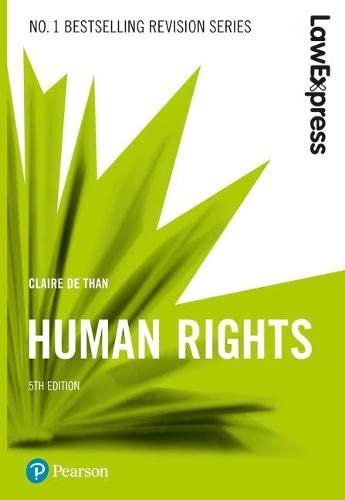Question
For this study, only identify the threats to internal validity, do not critique broader methodological issues and do not simply list all threats and create
For this study, only identify the threats to internal validity, do not critique broader methodological issues and do not simply list all threats and create scenarios for how they might all apply.
Question 1 [10 points]: A police organization wanted to run a diversion program in order to reduce recidivism among first time young offenders aged 13 and 14 charged with minor shoplifting offences. The program consisted of attending a weekly two-hour anti-shoplifting workshop for one month (4 workshops in total). Once the youths completed the program, the charges would be dismissed. In order to evaluate the effect of this program on recidivism, the police chief hired an independent researcher to randomly assign youths who were charged, for the first time, with minor shoplifting offences to receive the program or not. The researcher randomly assigned 150 youths to receive the program (experimental group) and 150 youths to proceed The average to court (control group). However, an officer reviewed the selection to be sure that only those cases that were in the public interest to be dealt with outside of court were included in the experimental group. This resulted in 110 youths being in the experimental group and 190 being in the control group. As the program began, defence counsel and youths themselves heard that this option (diversion) was available to some youths but not others. They thus began strongly advocating for a diversion program for all first-time minor offenders arguing that it was unfair not to allow broader access. In the end, the court created its own diversion program available for all first-time offenders that Crown attorneys could send youths to instead of proceeding with the charge. It took one month for everyone in the experimental group to finish the diversion program, but unfortunately, 27 youths dropped out part way through, leaving 83 in the experimental group. A month after the youths in the experimental group completed the program the researcher hired by the police - but not in any way associated with the police - contacted the youths who completed the program and asked how many offences they committed in the last month. The same was done with the control group - a month after their case was disposed of, the researcher contacted the 190 youths from the control group and asked how many offences they committed in the last two months. To test the effectiveness of the diversion program on recidivism, the youths' self-reported offending was used (described above) along with the number of new charges youths accumulated within six months following the intervention (diversion or court). In order to keep the groups equivalent in size, the first 83 youths that the researcher found charge data on were used for the control group.
| Self-Reported Offending Average number of reported offences | New Charges Average number of charges | |
| Experimental group | 2.3 (N=83) | 3.6 (N=83) |
| Control group | 5.4 (N=190) | 9.0 (N=83) |
Looking at the above table, the police chief saw that his program was an immediate success - there were fewer self-reported offences in the experimental group immediately following the completion of the program. Moreover, six months after the program - and using a different measure of "offending" (charge data), the results were consistent - fewer charges in the experimental group compared to the control group.
Identify and explain any threats to internal validity with this experiment.
Step by Step Solution
There are 3 Steps involved in it
Step: 1

Get Instant Access to Expert-Tailored Solutions
See step-by-step solutions with expert insights and AI powered tools for academic success
Step: 2

Step: 3

Ace Your Homework with AI
Get the answers you need in no time with our AI-driven, step-by-step assistance
Get Started


